USTreasuryMarket.com: 1. Letter, 2. Government Response, 3. Data: Canada
Treasury Bond Market: Data:
Canada $2.5 Billion 10-Year
Market information strongly suggests that one or more dealers successfully front-ran a large purchase of 10-year Treasury notes made at the October 27, 1998, pricing of this sovereign bond issue.
Chronology
- Tuesday, October 27, 1998
- 7:30 a.m.
- J.P. Morgan in-house deal summary lists Canada issue as $1 billion of 10-year bonds:
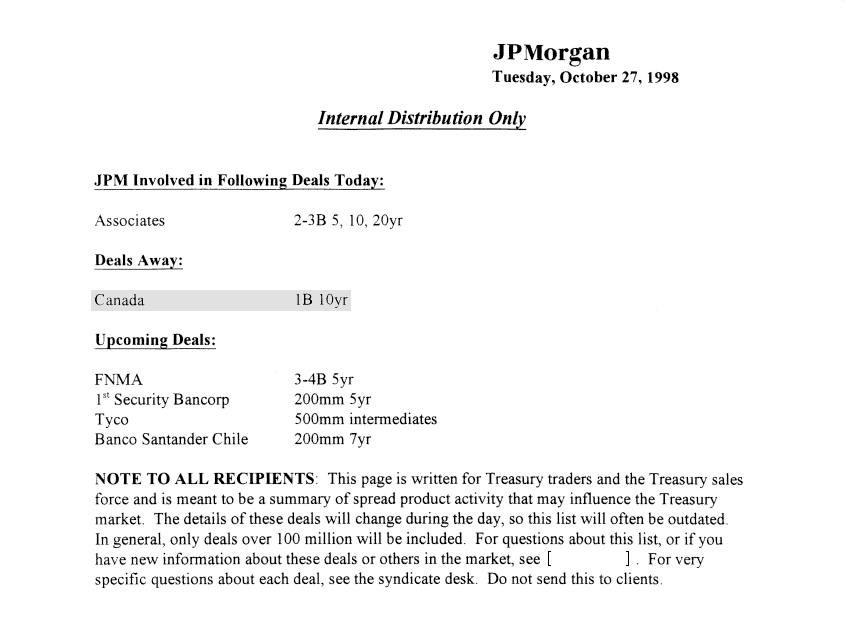
- ~10:40
- J.P. Morgan traders remark that there is a large 10-year Treasury note buyer in the interdealer brokers.
- 10:41
- Thomson Global Markets, an electronic news service, describes the deal’s size as $2.5 billion. The lead underwriters are Goldman Sachs, Royal Bank of Canada, and Warburg Dillon Read. Pricing is expected by 11:00:
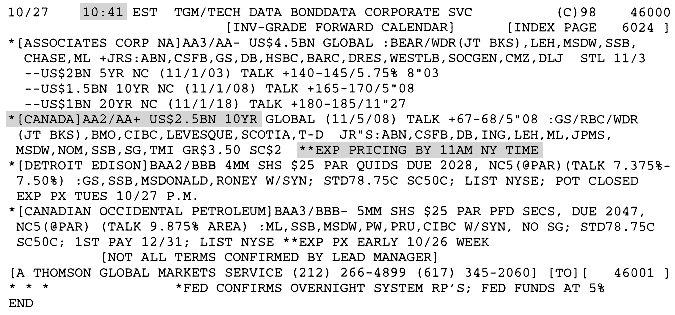
$51 million 10-year Treasury notes (subsequent broker references on this page are also to millions of 10-year notes unless stated otherwise) trade up at 107-23+ at Cantor (perhaps worked-up higher):

- 10:42
- $50 trade up at 107-24 at Cantor (perhaps worked-up higher):

- 10:43
- 107-24+ bid for $100 at Liberty (see 10:45 for resulting trade); $1 offered at same price at Garban:
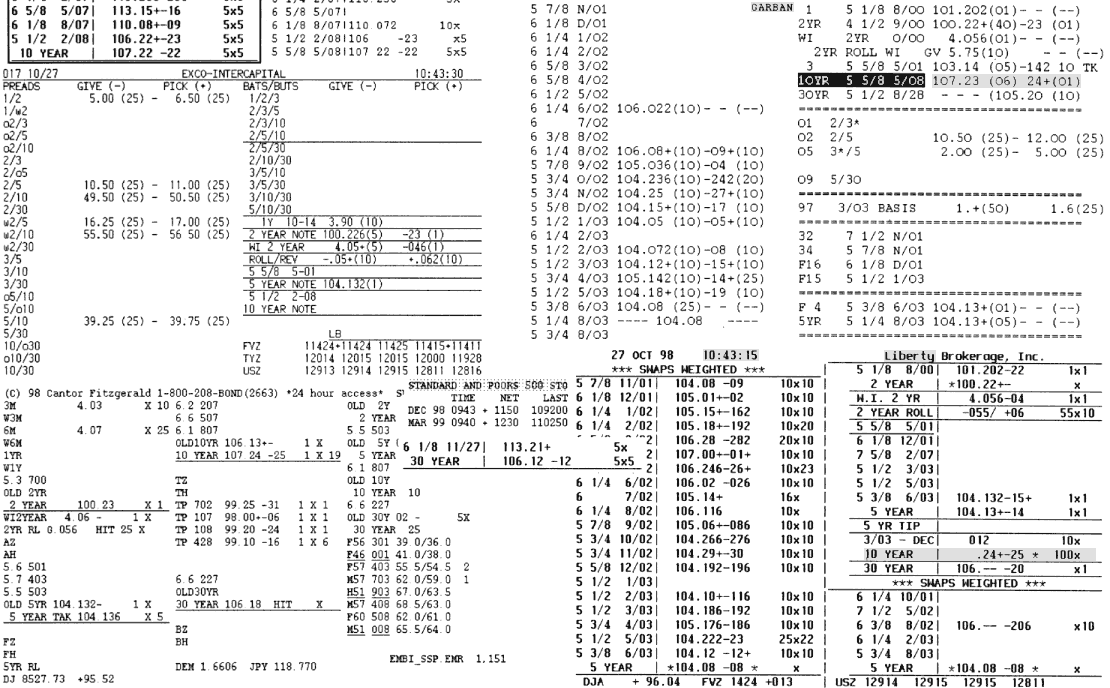
- 10:44
- Dow Jones Newswires reports that issue’s size has been increased from $1 billion to $2.5 billion (the larger size was reported by Thomson at 10:41) and that pricing is expected late morning:
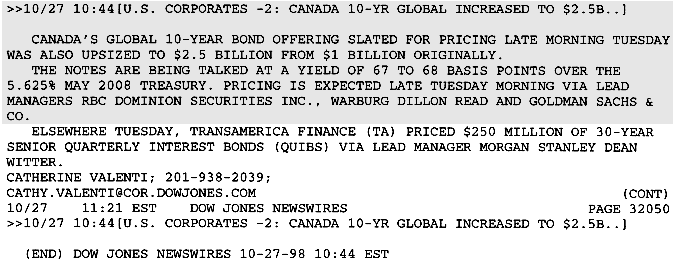
- 10:45
- $495 trade down at 107-24+ at Liberty (trade is still being worked-up in this screen shot, which also shows $1 down at 107-25 at Cantor): first buyer (the bidder seen at 10:43) buys $100; second buyer, who has been buying since 107-21+, buys $395:

- 10:47
- 107-24+ bid hit at Cantor, $10 down at 107-24 at Liberty as market is well-offered:

- 10:48
- Dealer who bought $395 at 107-24+ at Liberty buys another $212 at the same price. Market goes bid as other dealers realize he is still buying.
- 10:51
- Dealer who has been making large purchases at Cantor during this period buys more down at 107-26.
- 10:53
- The large buyer at Liberty buys more down at 107-30.
- 10:55
- Cantor’s large buyer buys ~$300 down at 107-31+, bringing his total 10-year purchases to ~$1 billion. J.P. Morgan traders conclude [correctly] that deal is being priced off of this trade.
- 10:56
- ~$25 trade at 108-0 at Liberty, different buyer.
$83 offered at 107-31 at Cantor:

- 10:57
- Offered at 107-27 at Cantor after going down at that price:
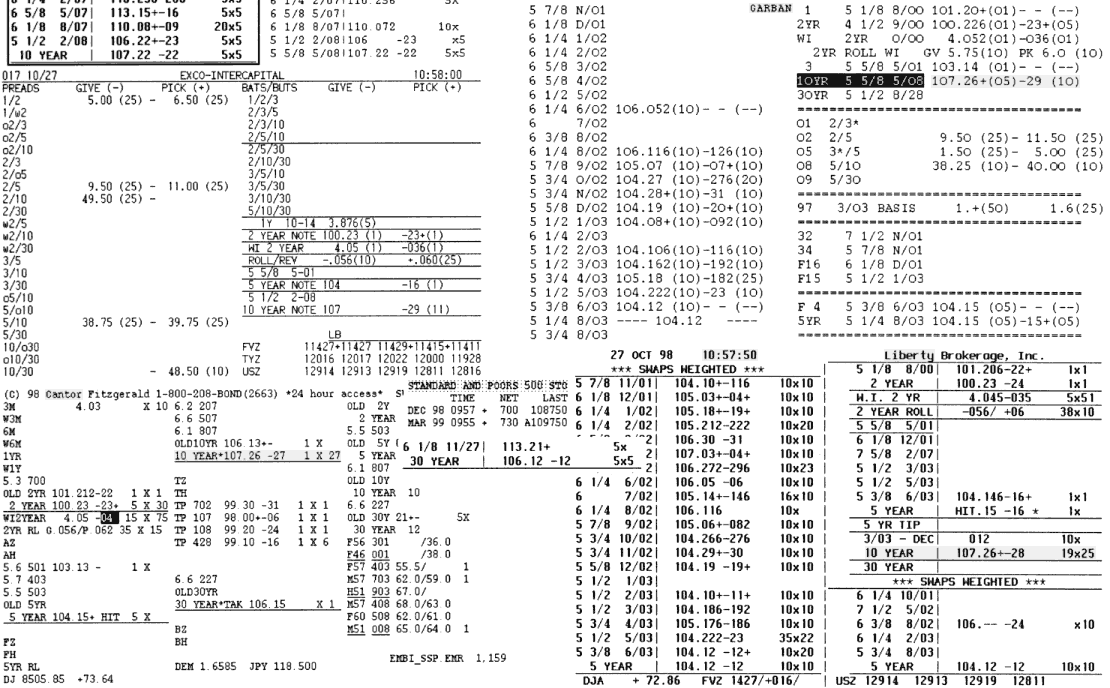
107-26+ bids hit at Garban and Liberty, 107-26 bid hit at Cantor:
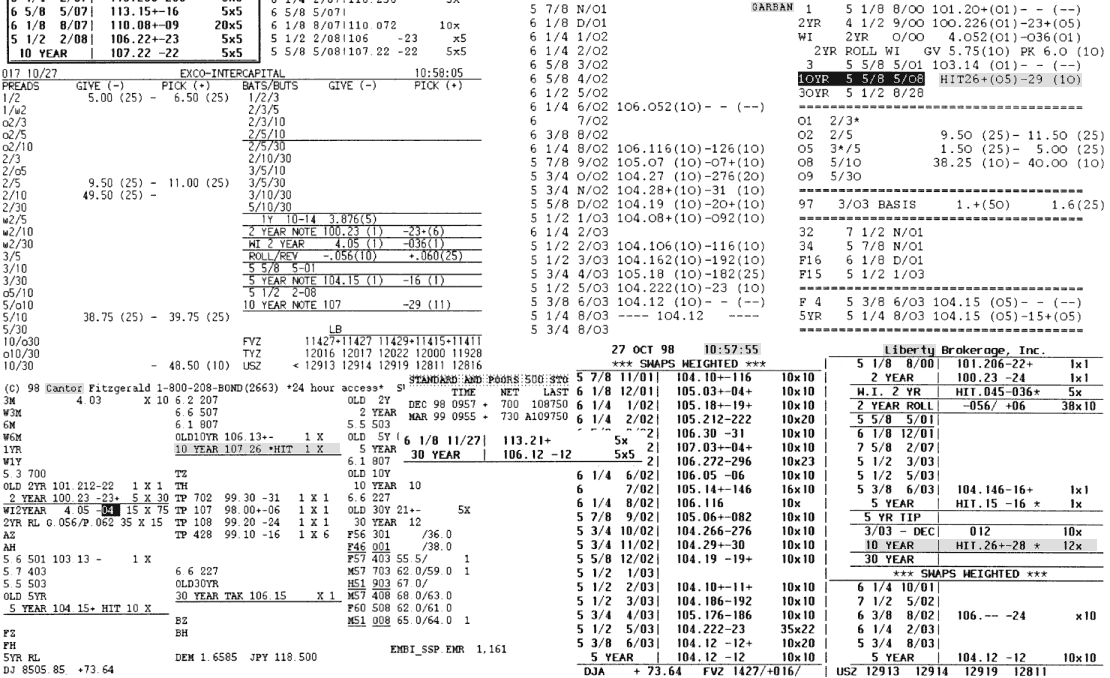
- 10:59
- 107-26 bid hit. Large buyer at Cantor has not bought more since 10:55 trade.
- 11:02
- Pricing announced on Dow Jones Newswires: Canada bonds to yield 5.253%, 67 basis points over Treasuries, meaning deal was priced off the 10-year at 107-31+ [5.253 − .67 = 4.583 = 10-year’s yield at 107-31+]:
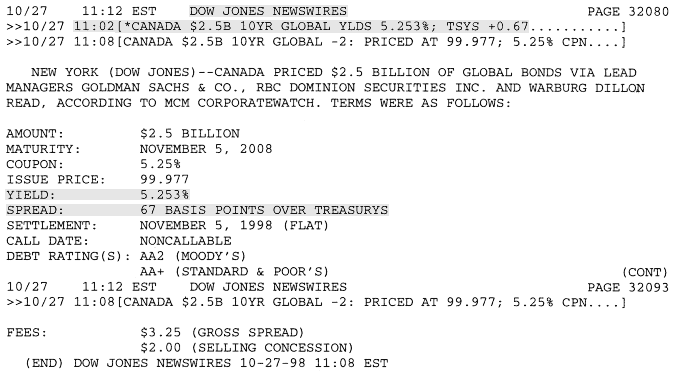
107-25+ bid hit at Cantor while offered at 107-25 at Liberty:

- 11:05
- 107-26+ offer taken at Cantor:
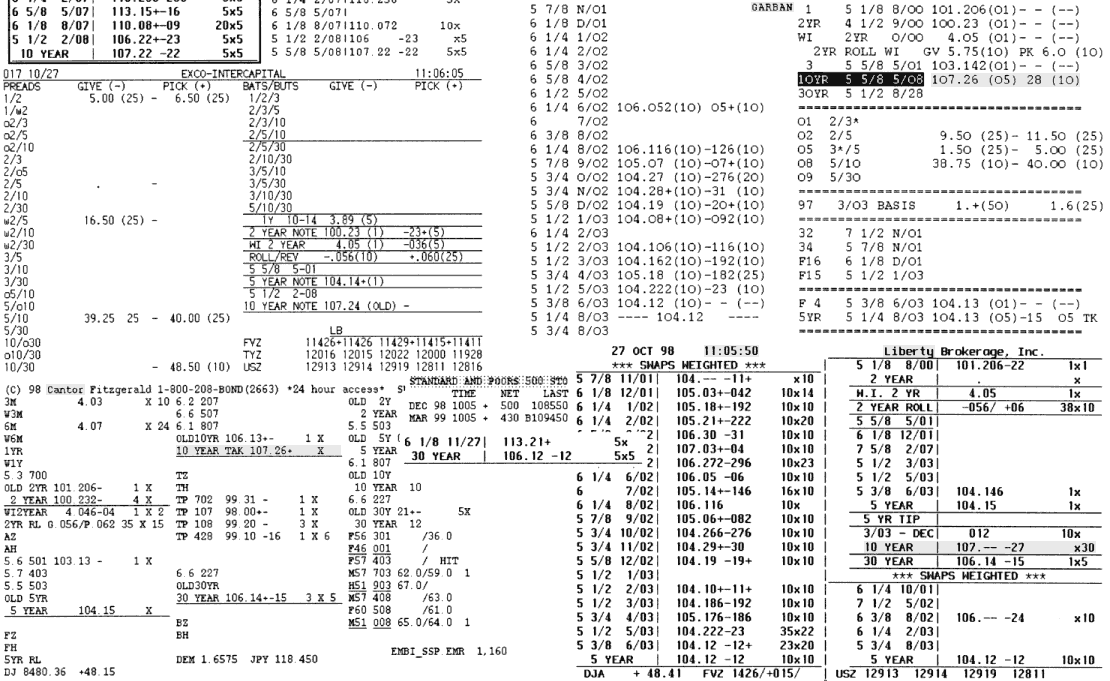
- 11:08
- Broker at Liberty says its large buyer bought almost a billion 10-years in total.
- 11:15
- 107-23 bids hit at Cantor, Exco, Garban, and Liberty:
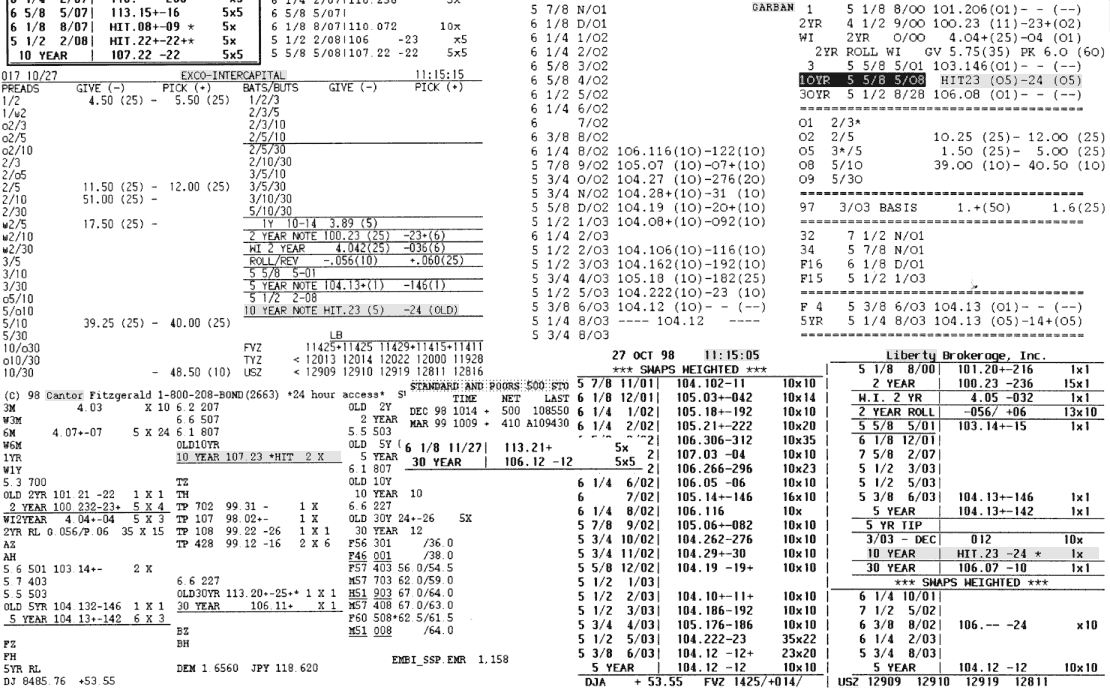
- 11:23
- Offered at 107-22 at Cantor, Exco, and Garban:
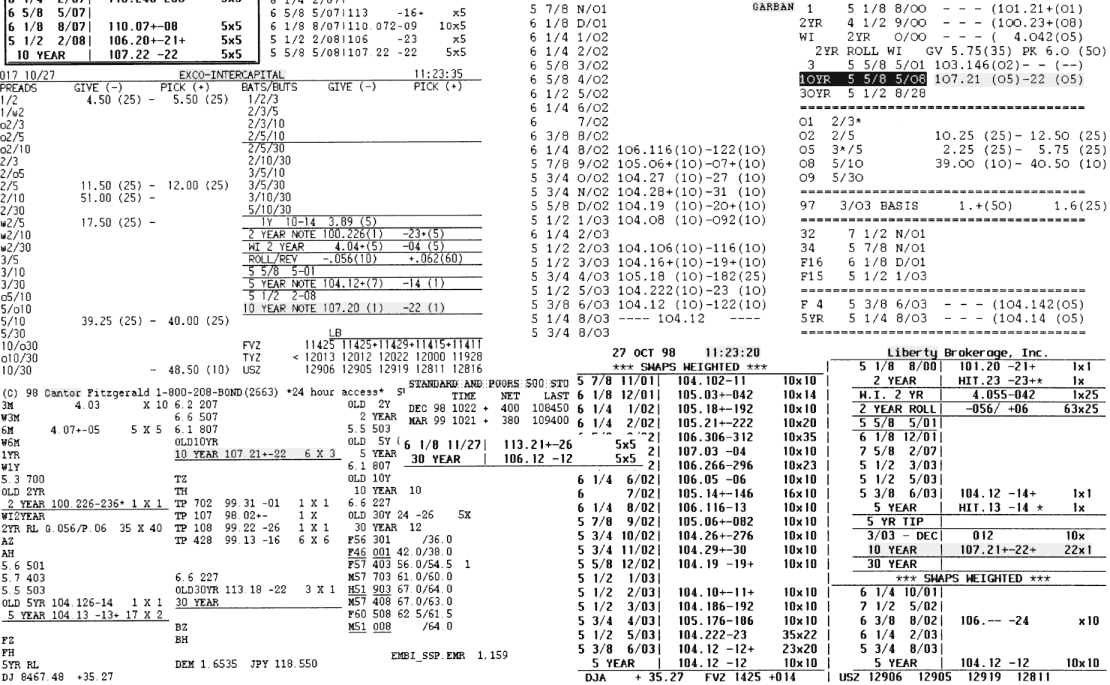
- 1:05 p.m.
- Thomson commentary states that hedging of Canada’s and Associates’ issues has driven Treasury prices for the past few hours, with large purchases of 10-years having occurred (Canada) or going to occur (Associates) on their pricing. (“10-year paper … outperformed on the intermediate portion of the curve” means that its yield fell more than the 5-year’s during the morning’s uptrade.):
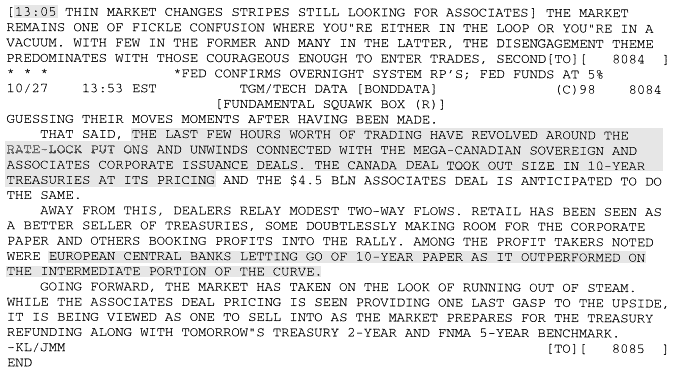
Charts and Tables
The 10-year price off which the issue was priced, 107-31+, is only a + below the day’s high, as shown by this tick-time plot of GovPx 10-year trades:
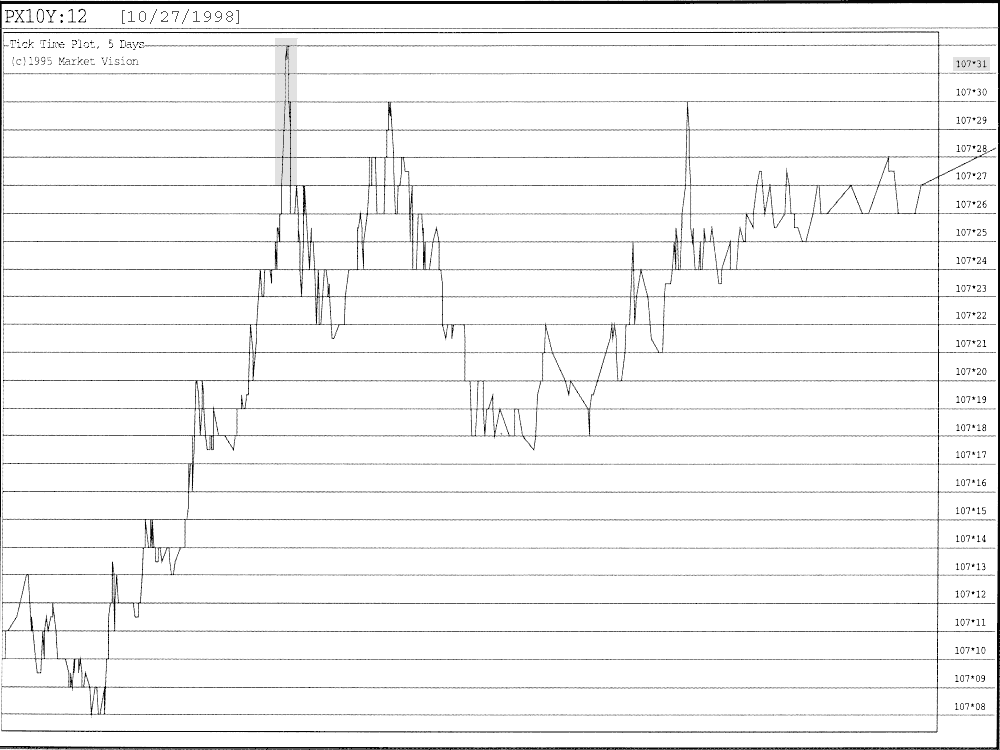
Table of GovPx 10-year time & sales (source data for above chart):
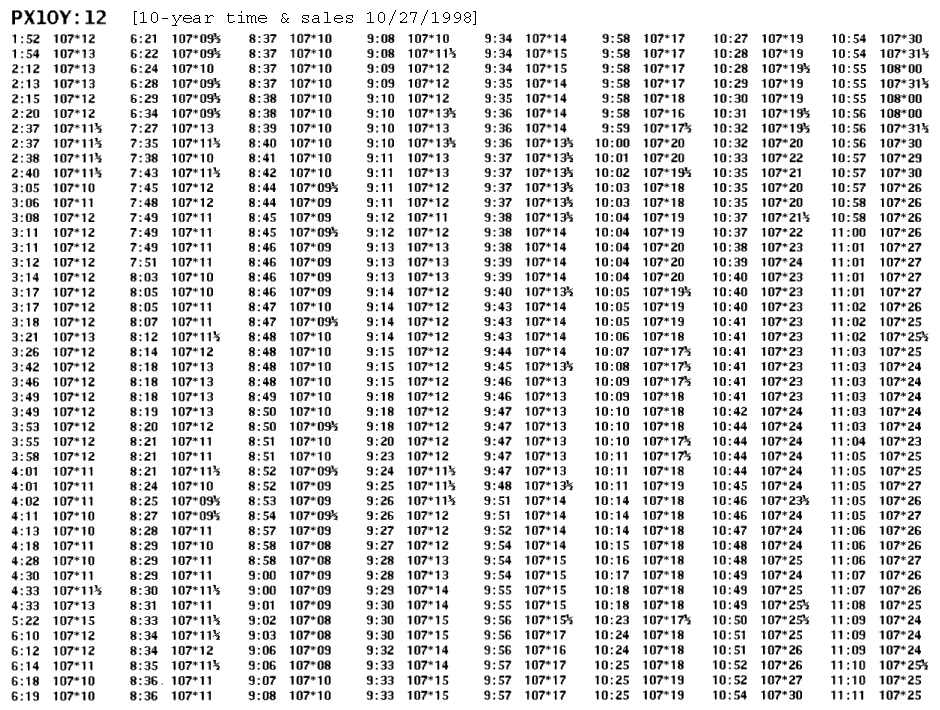
107-31+ was the 10-year’s high trade for the day at Cantor (the day’s range did not expand after 11:13, when this was printed):
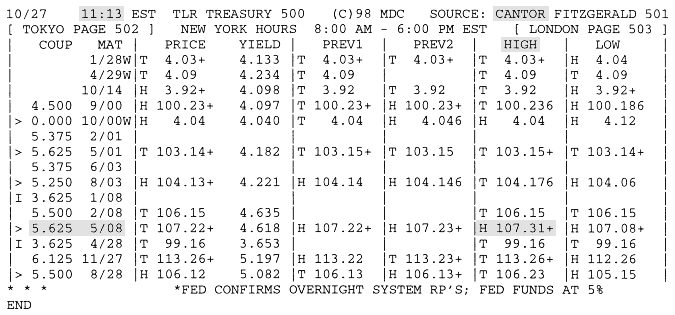
Commentary
This deal pricing exhibits both signs of front-running: a large, obvious buyer in the interdealer brokers and pricing at a localized extreme. The front-running was apparent to traders with no involvement with the deal, who correctly identified the moment of pricing, and described matter-of-factly by a news service.
Although front-running of a rate-lock unwind is usually indistinguishable from that of an interest-rate swap, the late increase in the size of this deal from $1 to $2.5 billion and the aggressive purchase of $2 billion or more 10-years through interdealer brokers suggest that it was probably swapped, not rate-locked. If the deal had been rate-locked it is unlikely that the size of the hedge would have been increased commensurately so close to the pricing (the increased size was probably decided an hour or so prior to its 10:41 a.m. announcement by a news service, but almost certainly not soon enough to make selling and then buying back an additional $1.5 billion 10-years sensible). The size of the Treasury hedge for a swap, however, would change with the size of the underlying bond (assuming the entire proceeds were swapped) regardless of when the increase was decided.
Estimated Profit
Assuming the dealer sold $2.5 billion 10-years (either to its swap desk for an interest-rate swap or directly to the issuer for a rate-lock unwind) at the price the deal was spread off of (107-31+), its profit on the ~ $600 million 10-years it bought at 107-24+ in two trades at Liberty would have been $1.3 million (600 × 7 32nds × $312.50 per 32nd per million = $1,312,500). The dealer would have broken even on the ~$300 million bought at 107-31+. Assuming an average purchase price of 107-27+ on the ~$1.6 billion balance yields an additional profit of $2.0 million (1,600 × 4 × $312.50 = $2,000,000), for a total profit of $3.3 million. This estimate probably significantly understates the actual profit: the 10-year traded above 107-27+ for only about five minutes around the time of pricing, and prior to 10:30 a.m. it traded between 107-08 and 107-20. Profit increases by $500 thousand for each thirty-second reduction in the average purchase price on the $1.6 billion balance (1,600 × 312.50 = $500,000).
The estimate does not include the underwriting fees on the issue ($3.25 per thousand gross spread × $2.5 billion = $8.125 million) or the dealer’s swaps desk’s profits, or, alternatively, profits previously realized putting on a rate-lock. Investors who bought portions of this deal outright on its pricing (i.e., without selling an equivalent amount of Treasuries) received a lower yield than they would have absent front-running.
Further Investigation
I asked the Bank of Canada if this issue was swapped or rate-locked and if it was, which dealer handled the transaction:
From: Bank of Canada Public Information/Information Publique
Sent: Monday, March 9, 2009 3:46 PM
Subject: RE: Front-running connected to Canada $2.5 billion 10-year global bond?
Good afternoon,
In response to your request, the main underwriters of these bonds were RBC Dominion, Goldman Sachs and UBS [Warburg Dillon Read’s corporate parent] (there were other co-managers).
There was an interest rate swap attached to the bond issuance for $1.2 billion.
As part of the deal, the Government of Canada purchased US Treasuries with the proceeds of the bond issue.
Regards,
[ ]
Public Information
Bank of Canada
Bank of Canada officials subsequently explained that it matched its foreign currency assets and liabilities, meaning it would have purchased 10-year Treasuries with the $1.3 billion ($2.5 − $1.2) of the deal that was not swapped. In addition, the swap dealer needed to purchase approximately $1.2 billion 10-years to hedge the interest-rate swap, so a total of $2.5 billion 10-years were purchased in connection with this offering. The Bank would not tell me which dealer (or dealers—Canada could have used one for its Treasury purchase and another for its swap, with both almost certainly selected from among the three lead underwriters) executed these transactions. Securities regulators, however, could identify the dealer and then examine its (or the interdealer brokers’) trading records for evidence of front-running.
[This deal pricing was presented to the Securities and Exchange Commission on June 24, 2004.]
USTreasuryMarket.com: 1. Letter, 2. Government Response, 3. Data: Canada
Please e-mail if you have comments or questions or would like to be notified of new content.
© USTreasuryMarket.com



















